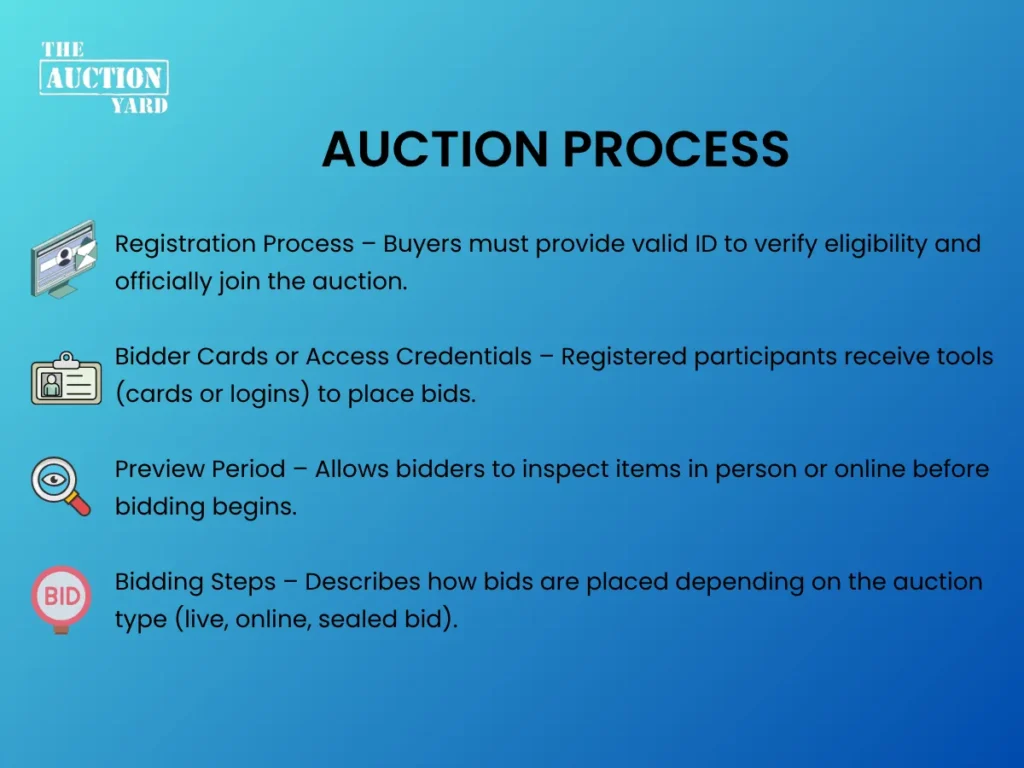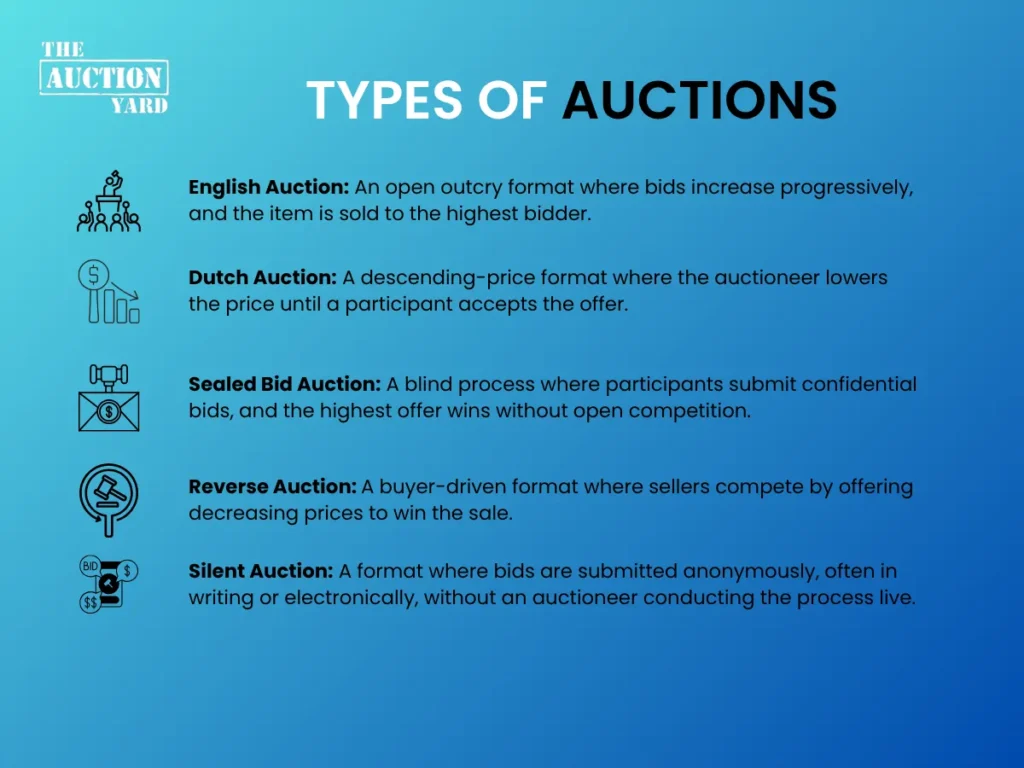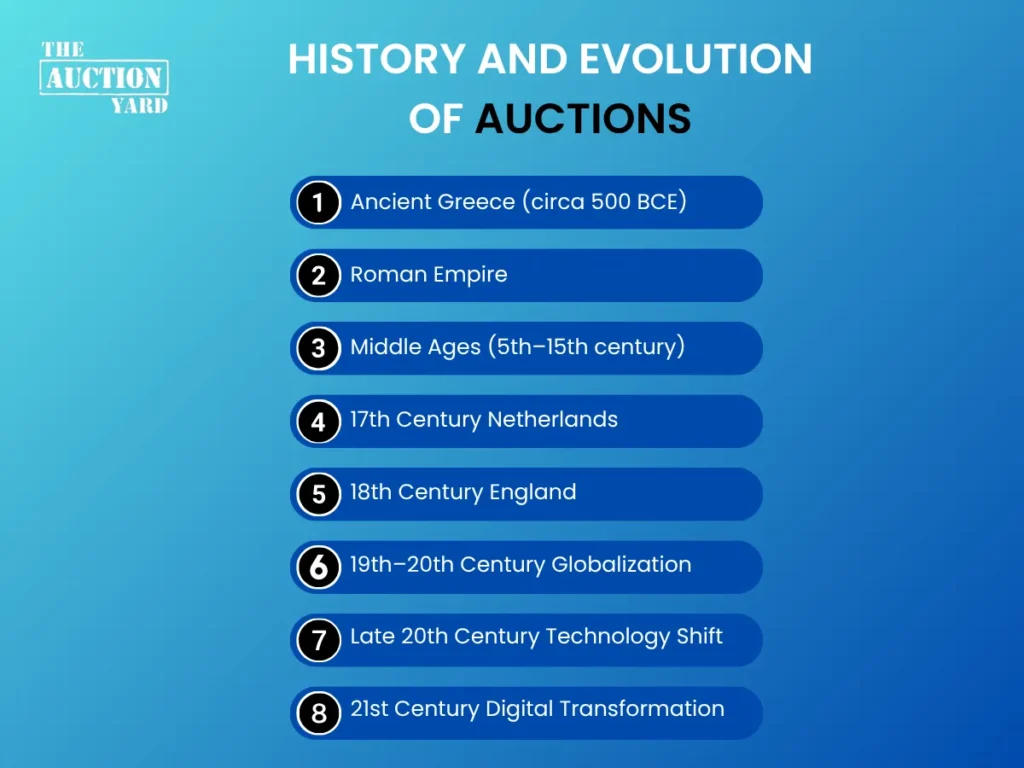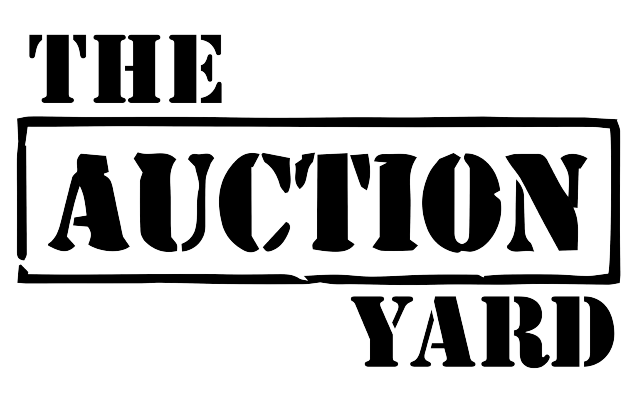What Is an Auction? Definition, Process, Types, Benefits, and Challenges

An auction is a structured process where buyers compete by placing bids to purchase goods or services. The item is awarded to the participant who submits the highest valid bid, allowing demand to drive price through open competition.
Common across sectors like automotive, real estate, equipment, and collectibles, auctions offer a reliable method for buying and selling. They promote efficient transactions through active participation and timely decision-making, letting the market determine real-time value.
Unlike fixed-price sales, auctions involve dynamic bidding, often resulting in better pricing for high-demand or unique items. Online platforms have expanded access, enabling virtual participation from anywhere.
According to Stanly Community College, an auction is a method of selling property in a public forum through open and competitive bidding. Also known as a public auction or auction sale, this format reinforces transparency and responsiveness in market exchanges.
Understanding the core principles of how auctions work helps participants approach them strategically, whether buying, selling, or investing in specialized assets.
Auction Terminology
Understanding auction terminology is essential for navigating the auction process with confidence. Each term reflects a key role, rule, or mechanism that defines how auctions operate in various contexts, from live events to digital bidding platforms.
This section introduces the foundational terms that shape the auction environment. From identifying the role of the bidder to understanding what an auctioneer does, these definitions create clarity for both new and experienced participants. Grasping this vocabulary improves transparency and ensures that buyers and sellers can engage more effectively in any auction setting.
Key Terms and Roles
Every auction operates through clearly defined roles and interactions that guide the bidding process from start to finish. Whether you're participating in a live event or an online platform, understanding who is involved and how each role functions is essential.
Below are the key terms that define participants and their actions within the auction environment:
- Auction: A method of selling goods or services through competitive bidding, where the highest bid wins the item.
- Auctioneer: The individual who conducts the auction, announces bids, and ensures rules are followed throughout the process.
- Bidder: A person or entity who places offers during an auction. Bidders compete against each other to purchase the listed item.
- Bidding: The act of making an offer to buy an item at a stated price. Bidding progresses until no higher offers are made.
Auction House and Auctioneer
In every auction, the auction house and the auctioneer support the structure and integrity of the event. Together, they manage both the logistical framework and the live execution of bidding activities.
The auction house serves as the organizing body behind the auction. It manages tasks like listing items, registering bidders, and handling payments. Auction houses may operate in physical locations or through online platforms, depending on the type of auction.
Working on behalf of the auction house, the auctioneer conducts the bidding process. They announce bids, recognize participants, maintain order, and ensure that auction rules are followed. Their role is critical to creating a fair and engaging experience for all bidders.
These two roles are tightly interlinked. While the auction house provides structure and reach, the auctioneer brings order and transparency to the live event. Together, they form the operational backbone of any successful auction.
Auction Process

The auction process is a step-by-step sequence designed to ensure fairness and transparency. It begins with participant registration, where buyers provide identification and receive bidder cards or login credentials. A preview period may follow, allowing potential bidders to examine listed items.
Bidding then takes place according to the auction format, with offers made in person, online, or through sealed submissions. The auction continues until no higher bids are placed and the item is awarded to the highest valid offer. Throughout the process, rules and procedures guide bidding activity, closing criteria, and sale confirmation.
Bidding Mechanics and Registration
Participating in an auction requires understanding both how to register and how bidding works. These steps ensure that the process remains orderly and accessible to all eligible participants.
- Registration Process: Before the auction begins, buyers must register by providing valid identification. This step verifies eligibility and creates an official record of all participants.
- Bidder Cards or Access Credentials: Once registered, bidders receive a numbered card or a secure login, which they use to place bids either in person or online.
- Preview Period: Before the auction, a scheduled time allows registered bidders to inspect items either at the auction site or through an online catalog. This helps bidders make informed decisions.
- Bidding Steps: Bidders place offers based on the auction format. In live auctions, this may involve raising a card or responding verbally. Online auctions typically require clicking to place incremental bids. In sealed bid formats, participants submit confidential offers once.
These mechanics form the foundation of every auction. Following them closely supports a fair, competitive environment and helps bidders engage effectively throughout the event.
Auction Rules and Procedures
Every auction operates under a set of formal rules that guide the bidding process, ensure fairness, and uphold legal standards. These procedures help prevent disputes and create a clear framework that all participants must follow. Understanding these elements is essential for both first-time and experienced bidders.
- Auction Rules: The set of conditions that govern participant behavior, acceptable bidding increments, and dispute resolution protocols.
- Auction Guidelines: Detailed terms covering payment methods, item removal logistics, and any fees or buyer premiums. These are provided before the auction and must be accepted during registration.
- Opening Bid: The starting price at which bidding begins, set either by the auctioneer or based on seller terms.
- Auction End: The point at which bidding closes. This may occur when no further bids are made or when a preset timer expires in online formats.
What Are the Different Types of Auctions?

Auctions are conducted in various formats, each designed to suit different market goals, bidding dynamics, and asset types. Recognizing how each type functions helps both buyers and sellers make informed decisions and choose the most effective approach.
The following are the primary types of auctions, each with unique bidding structures and transaction strategies:
- English Auction: An open outcry format where bids increase progressively, and the item is sold to the highest bidder.
- Dutch Auction: A descending-price format where the auctioneer lowers the price until a participant accepts the offer.
- Sealed Bid Auction: A blind process where participants submit confidential bids, and the highest offer wins without open competition.
- Reverse Auction: A buyer-driven format where sellers compete by offering decreasing prices to win the sale.
- Silent Auction: A format where bids are submitted anonymously, often in writing or electronically, without an auctioneer conducting the process live.
Each format serves different use cases, from real-time bidding for collectibles to government procurement and charitable fundraising.
English Auction
Among all auction formats, the English auction is the most familiar and straightforward for participants. Its open, competitive nature makes it suitable for a wide range of items and audiences. The process involves public bidding where prices rise incrementally until no higher offers are made.
Some of the key features of an English auction are listed below:
- Open Outcry: Bids are made openly, either in person or through an online interface, allowing all participants to track the current offer.
- Ascending Bids: Each new bid must be higher than the last, continuing until no further bids are received.
- Highest Bid Wins: The item is awarded to the participant with the highest final bid at the close of the auction.
- Common Uses: Typically used for selling collectibles, antiques, fine art, and estate assets where open competition helps achieve strong sale prices.
Dutch Auction
In contrast to traditional auction formats, the Dutch auction begins with a high price that gradually decreases over time. Rather than encouraging back-and-forth competition, it rewards speed and decisiveness. The first participant to accept the current price wins the item, making this format efficient and fast-paced.
The key features of a Dutch auction are as follows:
- Descending Price: The auction starts at a high initial price that drops at fixed intervals until a bid is placed.
- First Acceptance Wins: The auction ends immediately when a participant accepts the current price.
- No Competitive Bidding: Bidders do not compete with one another directly. Timing is the key to securing the item.
- Common Uses: Typically used for flower sales in the Netherlands, IPO pricing models, and government bond offerings.
Sealed Bid Auction
In a sealed bid auction, participants compete without visibility into one another's offers. Each bidder submits a confidential proposal, and the seller reviews all entries after the deadline. The item is awarded to the highest offer, making this format heavily reliant on individual judgment rather than reactive bidding.
Some of the primary features of a sealed bid auction are discussed below:
- Confidential Bidding: All bids are submitted privately, with no interaction or visibility between bidders.
- One-Time Submission: Participants typically have only one opportunity to submit their best offer.
- Highest Bid Wins: The item is sold to the highest bidder, with no negotiation or second round.
- Common Uses: Common in government procurement, real estate transactions, and corporate tenders where impartiality and structure are prioritized.
Reverse Auction
Unlike traditional auctions where buyers compete to purchase an item, a reverse auction flips the process. Here, the buyer initiates the auction, and multiple sellers compete by offering decreasing prices. The seller willing to provide the item or service at the lowest acceptable price typically wins the contract.
Key features of a reverse auction:
- Buyer-Initiated: The buyer defines the requirements and invites sellers to submit competing price offers.
- Descending Offers: Sellers lower their prices to outbid competitors and win the sale.
- Lowest Offer Wins: The contract or sale is awarded to the seller with the lowest qualifying bid.
- Common Uses: Frequently used in government procurement, corporate sourcing, and bulk purchasing where cost reduction is a primary goal.
Silent Auction
In settings where formality or social atmosphere is important, the silent auction provides an alternative to live bidding. Rather than competing openly, participants submit written or electronic bids without interacting with other bidders. This format promotes ease of participation and reduces pressure, making it well-suited for events focused on fundraising or community engagement.
The main features of a silent auction are listed below:
- No Auctioneer: Bidding is self-directed. There is no live facilitation or vocal bid calling during the event.
- Anonymous Bidding: Offers are submitted privately, and participants do not see competing bids while the auction is active.
- Highest Bid Wins: After the bidding period closes, the highest recorded offer secures the item.
- Common Uses: Frequently used in charity events, school fundraisers, and local functions where a relaxed, inclusive format is preferred.
Compare Auction Types
Select an auction type to view its core features.
English Auction
- Format: Open outcry with ascending bids
- Bid Visibility: Public
- Winning Criteria: Highest bid wins
- Use Cases: Antiques, art, collectibles
- Strategy Tip: Bid late and watch competitors
Dutch Auction
- Format: Descending price until accepted
- Bid Visibility: Single price point
- Winning Criteria: First acceptance wins
- Use Cases: Flowers, IPO pricing, bonds
- Strategy Tip: Act fast to beat others
Sealed Bid Auction
- Format: One-time private bids
- Bid Visibility: Confidential
- Winning Criteria: Highest bid wins
- Use Cases: Real estate, tenders
- Strategy Tip: Research value & bid strong
Reverse Auction
- Format: Sellers lower prices
- Bid Visibility: Visible to buyer
- Winning Criteria: Lowest bid wins
- Use Cases: Procurement, sourcing
- Strategy Tip: Offer best value early
Silent Auction
- Format: Anonymous, written bids
- Bid Visibility: Not visible to others
- Winning Criteria: Highest bid wins
- Use Cases: Charity, fundraising
- Strategy Tip: Submit strong upfront bid
What Are the Benefits of Auctions?
Auctions offer distinct advantages for buyers, sellers, and the broader market. Their structure promotes competitive pricing, efficient transactions, and transparent decision-making. By creating urgency and encouraging open participation, auctions can unlock value that fixed-price models may not capture.
The benefits of auctions fall into three core categories:
- Buyer Benefits: Access to discounted prices, rare or high-value items, and competitive opportunities not always available through traditional sales.
- Seller Benefits: Greater control over the sales process, increased bargaining power, and the potential for higher returns through competitive bidding.
- Market Benefits: Improved price discovery, greater transparency in transactions, and more dynamic interaction between supply and demand.
Buyer Benefits in an Auction
For buyers, auctions present a structured way to secure value through competitive pricing and real-time decision-making. The format creates opportunities that are often unavailable in fixed-price markets, particularly when access to exclusive items or transparent price formation is important. This environment gives buyers several advantages:
- Opportunity to Buy at a Discount: Items may sell below market value, particularly in auctions with low competition or time-sensitive sellers.
- Access to Rare or Unique Items: Auctions frequently feature assets such as estate goods, vintage equipment, or limited collectibles that are not listed through standard retail channels.
- Transparent Pricing Process: Bidding activity reveals what others are willing to pay, offering clarity on true market value.
- Strategic Advantage for Prepared Buyers: Buyers who understand item worth and auction pacing can place well-timed bids to win valuable assets.
Seller Benefits in an Auction
Auctions provide sellers with an efficient way to reach motivated buyers while maintaining control over pricing terms and timelines. The competitive format not only accelerates the sale process but also increases the potential for higher returns by encouraging bidder engagement. This creates a favorable environment for sellers seeking fast, transparent, and outcome-driven transactions.
Key benefits for sellers include:
- Control Over Sales Process: Sellers can define starting bids, reserve prices, and auction timelines, ensuring alignment with their goals.
- Price Maximization Through Competition: The presence of multiple interested buyers can drive up the final price, especially for in-demand or unique items.
- Faster Sales Cycle: Auctions establish a fixed endpoint, reducing the uncertainty and delays often associated with traditional selling methods.
- Transparency and Equal Access: Sellers benefit from a public and regulated process where all bidders follow the same terms, reducing negotiation friction.
Market Benefits
Beyond individual buyers and sellers, auctions contribute to broader market efficiency. By encouraging open participation and real-time value determination, auctions support clearer pricing signals and foster trust among stakeholders. In markets where transparency and speed matter, this format creates several system-wide advantages:
- Price Discovery: Auctions allow supply and demand to interact directly, revealing the true market value of an asset based on active competition.
- Market Transparency: The visibility of bids and bidding behavior helps reduce information asymmetry and increases fairness across participants.
- Efficient Resource Allocation: Items are awarded to those who value them most, improving the allocation of goods across market participants.
- Trust in Process: Standardized rules and open participation help reinforce the credibility of auction outcomes, especially in regulated or public sectors.
What Challenges Do Auctions Face?
While auctions offer many advantages, they also come with potential challenges that affect participants and the overall integrity of the process. These challenges typically fall into legal, financial, and competitive categories. Recognizing and addressing these issues is important for maintaining trust, ensuring compliance, and protecting both buyers and sellers from risk.
Common auction challenges include:
- Legal Challenges: Compliance with contract law, auction-specific regulations, and licensing requirements can be complex, especially across jurisdictions.
- Financial Risks: Participants may face unexpected costs, such as buyer premiums or payment default from winning bidders.
- Competitive Risks: Auctions can be vulnerable to unethical practices like collusion, bid rigging, or fraudulent listings, which undermine fairness.
Each of these areas presents operational and reputational risks that auction platforms and participants must manage carefully.
Legal Challenges
Legal considerations are a critical aspect of running or participating in auctions, especially when transactions involve high-value assets or cross-regional regulations. Failure to meet legal obligations can result in disputes, penalties, or invalidated sales. For auction platforms, ensuring legal compliance is central to maintaining operational credibility and buyer-seller trust. These challenges often include:
- Auction Legality Issues: Different regions may impose unique rules about how auctions can be conducted, including licensing, advertising, and disclosure standards.
- Regulatory Compliance: Auction organizers must comply with local, national, or industry-specific regulations governing asset transfer, taxes, and consumer protection.
- Contractual Obligations: Winning bids typically result in binding agreements. Legal conflicts may arise if buyers back out or sellers fail to deliver as promised.
To avoid liability and ensure enforceability, auction procedures must align with applicable legal frameworks at every stage.
Financial Risks
Auctions can expose both buyers and sellers to financial uncertainty, particularly when participants are unprepared for added costs or contractual defaults. While competitive bidding often leads to favorable outcomes, the structure also creates financial pressure points that must be managed carefully. These risks include:
- Auction Costs: Buyers may be responsible for additional charges such as buyer premiums, taxes, or processing fees. Sellers may incur listing or commission costs charged by the auction house.
- Bidder Default: A winning bidder may fail to complete the transaction, resulting in revenue loss and the need to relist the item.
- Valuation Gaps: Rapid bidding can push prices beyond reasonable market value, leading to overpayment or regret purchases for the winning participant.
Clear terms, upfront cost disclosures, and bidder qualification procedures help reduce exposure to these risks and support smoother financial transactions.
Competitive Risks
While auctions are designed to be fair and transparent, they are not immune to unethical behaviors that distort competition. These risks threaten the credibility of the auction process and can lead to legal and reputational consequences for platforms and participants alike. Common forms of competitive manipulation include:
- Auction Fraud: False listings, misrepresented items, or fake bidders may be used to manipulate outcomes or inflate prices.
- Collusion: Two or more bidders may coordinate to suppress competition, keeping final prices artificially low.
- Bid Rigging: Sellers or insiders may engage in prearranged bidding patterns to drive up prices unfairly or exclude legitimate buyers.
To protect the integrity of auctions, organizers must monitor for irregular activity, enforce strict rules, and apply sanctions where misconduct is identified.
What Types of Auction Services Are Available?
Modern auctions are supported by a range of specialized services that enhance participation, extend seller reach, and simplify transaction logistics. These services are particularly valuable for high-volume, remote, or first-time participants who require added support or accessibility.
Auction services generally fall into three main categories:
- Bidding Services: Include proxy bidding and auction assistance, allowing individuals to place offers through agents or automated systems.
- Consignment Services: Help sellers list and manage items on their behalf, handling logistics, promotion, and final sale processing.
- Online Auction Platforms: Provide digital infrastructure for virtual bidding, item presentation, and real-time transaction management.
These auction services are essential for streamlining complex sales and making auctions accessible to a broader audience. At The Auction Yard, we offer these services through our online platform and physical auction yard in Peoria, allowing buyers and sellers to engage in person or remotely. Whether dealing in autos, equipment, estate items, or antiques, participants benefit from a fully supported process tailored to their needs.
Bidding Services
Some participants may prefer not to bid directly due to time constraints, location, or the need for expert input. To support these scenarios, auction houses offer bidding services that allow buyers to stay engaged without being present or fully hands-on. These services are commonly used in both high-value and remote bidding contexts.
Key types of bidding services include:
- Proxy Bidding: A representative or automated system places bids on behalf of the buyer according to predefined instructions or a set bid limit.
- Auction Bidding Assistance: Specialized agents or support staff help participants monitor bidding activity, assess item value, and submit offers at strategic moments.
These services provide convenience and help ensure that buyers can compete effectively, even when they are not directly involved in the live auction.
Consignment Services
When sellers prefer not to handle the auction process directly, consignment services provide a streamlined alternative. These services allow professionals to take over the preparation, promotion, and management of auction listings. This is particularly valuable for individuals or organizations looking to sell specialized or high-volume assets with minimal effort.
Common types of consignment services include:
- Selling on Behalf: The auction provider manages the full sales cycle, from cataloging the item and setting terms to conducting the auction and finalizing payment.
- Item Consignment: Sellers transfer their items to the auction platform under a formal agreement. The platform then showcases and sells the items on their behalf.
By outsourcing the selling process, consignors gain access to wider audiences, expert handling, and better presentation, leading to higher visibility and increased sale potential.
Online Auction Platforms
As digital participation becomes the norm, online auction platforms have transformed how auctions are conducted and accessed. These platforms enable users to browse listings, register, and place bids entirely online, removing geographical barriers and expanding market reach for both buyers and sellers.
Core features of online auction platforms include:
- Digital Auction Sites: Websites that host live or timed auctions, offering tools for item search, bidder registration, and secure payment processing.
- Virtual Bidding Platforms: Real-time interfaces that simulate the pace of live auctions, allowing remote participants to place bids and monitor activity from any location.
These platforms support efficient, scalable auctions and are especially useful for large inventories, time-sensitive sales, and international transactions.
Applications of Auctions
Auctions are used across a wide range of industries to facilitate the sale of both tangible and intangible assets. Their flexible structure and transparent process make them effective for selling high-value items, clearing estate inventories, or reallocating surplus property. Depending on the asset type, auctions can be conducted live, online, or through hybrid formats.
Key application areas include:
- Vehicle Auctions: Used for selling autos, trucks, machinery, and fleet equipment. These auctions serve private buyers, commercial dealers, and government agencies.
- Real Estate Auctions: Facilitate the sale of residential, commercial, and land properties, often in cases involving foreclosures, estate settlements, or investment opportunities.
- Collectibles and Antiques: Feature items such as fine art, estate jewelry, vintage goods, and historical artifacts, drawing interest from collectors and niche buyers.
These applications show how auctions serve not only as a sales tool but also as a strategic solution for efficient asset disposition across sectors.
Vehicle Auctions
Whether for individual cars or commercial fleets, a vehicle auction offers a practical and competitive method for selling transportation assets in volume or at speed. It allows sellers to connect with motivated buyers and provides a transparent pricing environment shaped by real-time demand.
Typical categories in vehicle auctions include:
- Autos: Passenger vehicles such as sedans, SUVs, and light trucks. Common sources include dealerships, leasing companies, financial institutions, and private sellers.
- Equipment: Encompasses heavy machinery, commercial trucks, and specialty vehicles used in industries like construction, agriculture, and logistics.
By combining market visibility with fast transaction cycles, vehicle auctions serve a critical role in asset turnover and fleet management.
Real Estate Auctions
For time-sensitive property sales or complex transactions, a real estate auction provides a transparent and deadline-driven alternative to traditional listing methods. This format appeals to both private owners and institutional sellers who need to reach serious buyers in a structured bidding environment.
Key property categories in real estate auctions include:
- Property: Includes residential homes, vacant land, and commercial buildings. Often listed due to foreclosures, estate settlements, or investment rotations.
- Housing: Refers to single-family homes, condos, and multi-unit dwellings. These are typically auctioned for quick sale or to maximize exposure in competitive markets.
Real estate auctions offer sellers speed and buyer engagement while allowing bidders to compete openly based on current market conditions.
Collectibles and Antiques
When selling rare, historic, or one-of-a-kind items, a collectibles and antiques auction offers a focused marketplace where enthusiasts and collectors compete for ownership. This format supports strong pricing outcomes by matching unique assets with highly interested buyers in a competitive setting.
Typical asset categories in collectibles and antiques auctions include:
- Antiques: Historical artifacts, furniture, fine art, and heirlooms. These items often come from estates, private collections, or museum deaccessions.
- Estate Items: Includes personal property from estate sales such as vintage jewelry, memorabilia, decorative pieces, and specialty objects with cultural or nostalgic value.
These auctions attract knowledgeable audiences and allow sellers to unlock the full market potential of rare and historically significant items.
History and Evolution of Auctions

Auctions have existed for thousands of years, evolving alongside trade systems, legal frameworks, and technology. From early public sales in ancient civilizations to the rise of real-time digital bidding, auctions have continually adapted to changing economic systems, societal norms, and technological advancements.
Major milestones in the history and evolution of auctions include:
- Ancient Greece (circa 500 BCE): Early auctions were used to sell slaves, war plunder, and surplus goods. Bids were made in public forums and conducted under strict civic rules.
- Roman Empire: Auctions (called auction) were common for liquidating estate goods and military spoils. Items were sold under a spear (sub hasta) to signify authority and legitimacy.
- Middle Ages (5th-15th century): Auctions were used in Europe for selling property of deceased nobles, religious holdings, and livestock, often managed by local lords or clergy.
- 17th Century Netherlands: The Dutch auction emerged, using descending price mechanisms for perishable goods like tulips and fish, establishing efficiency in high-volume trade.
- 18th Century England: Sotheby's (1744) and Christie's (1766) were founded, formalizing art and antiquity auctions for elite and institutional buyers.
- 19th-20th Century Globalization: Industrial growth and global trade networks expanded auction applications to real estate, machinery, and commodities markets.
- Late 20th Century Technology Shift: Online auction pioneers like eBay (founded in 1995) democratized access to auctions, introducing user-based listings and remote participation.
- 21st Century Digital Transformation: High-speed internet, mobile apps, and AI-driven platforms now enable global, real-time, multi-category auctions across consumer and enterprise markets.
This timeline illustrates how auctions have not only endured but evolved to remain relevant as a powerful market mechanism in both physical and digital economies.
Frequently Asked Questions
To bid at an auction, follow these steps to ensure your participation is valid, strategic, and within the rules of the auction format: Sign up with the auction provider and receive a bidder card or online login. Review the auction rules, bidding increments, and fee structure. Bid live by raising your card, online by clicking to bid, or submit a sealed offer if required. Track competing bids and adjust your strategy if necessary. If you win, pay the final bid plus any applicable fees within the stated timeline. To bid effectively, stay within your budget and keep your attention on the auctioneer’s calls or platform updates to avoid missing your turn.
A bidder is a person or entity that places an offer to purchase an item during an auction. Bidders may participate live, online, or through a proxy. Each bid represents a legally binding intent to buy, and the highest bidder at the end of the auction is typically awarded the item.
In most cases, you cannot back out of an auction once you have placed the winning bid, as it creates a binding agreement. Withdrawal may result in financial penalties or legal action depending on the auction terms and local regulations. Always review the terms and conditions before participating to understand your obligations.
Common auction fees for buyers include a buyer’s premium, which typically ranges from 10% to 25% of the final bid amount. For example, if a winning bid is $10,000 and the buyer’s premium is 15%, the total amount paid by the buyer would be $11,500.
Likewise, sellers are usually charged a commission fee that ranges between 5% and 15% of the final sale price, depending on the auction house and item category. A seller of an estate item that sells for $5,000 might pay $250 to $750 in commissions.
Additional fees may include:
- Listing fees: Often flat rates between $25 and $100 to enter an item into the auction catalog.
- Handling or photography fees: Some platforms charge between $10 and $50 for professional imaging or preparation.
- Online platform fees: For internet-based auctions, digital service fees may apply, typically 1% to 3% of the sale price.
These costs vary by auction provider, asset category, and geographic region. Participants should always review the full fee schedule before registering or listing items.


